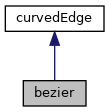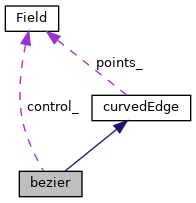Nth order bezier curve edge. Only interior control points should be specified. The outer points are taken as start and end. Note that the calculation of each point takes 0(N^2) time, where N is the number of control points. This edge type shouldn't therefore be used for finely discretised line data; polyLine or similar will be more appropriate for such cases. Beziers are useful for simple curved shapes such as aerofoils, or when you want an edge to match a specific direction at one, or both, or its endpoints. In comparison with BSplines, the grading of bezier edges should be smoother, and the code is much simpler. The algorithmic order is worse, however, and the edge will not follow the control points as closely.
More...
|
| | TypeName ("bezier") |
| |
| | bezier (const pointField &, const label start, const label end, const pointField &control) |
| | Construct from components. More...
|
| |
| | bezier (const pointField &, Istream &) |
| | Construct from Istream. More...
|
| |
| virtual | ~bezier () |
| | Destructor. More...
|
| |
| point | position (const scalar lambda) const |
| | Return the point position corresponding to the curve parameter. More...
|
| |
| scalar | length () const |
| | Return the length of the curve. More...
|
| |
| | TypeName ("curvedEdge") |
| | Runtime type information. More...
|
| |
| | declareRunTimeSelectionTable (autoPtr, curvedEdge, Istream,(const pointField &points, Istream &is),(points, is)) |
| |
| | curvedEdge (const pointField &points, const label start, const label end) |
| | Construct from components. More...
|
| |
| | curvedEdge (const pointField &, Istream &) |
| | Construct from Istream setting pointsList. More...
|
| |
| | curvedEdge (const curvedEdge &) |
| | Copy construct. More...
|
| |
| virtual autoPtr< curvedEdge > | clone () const |
| | Clone function. More...
|
| |
| virtual | ~curvedEdge () |
| | Destructor. More...
|
| |
| label | start () const |
| | Return label of start point. More...
|
| |
| label | end () const |
| | Return label of end point. More...
|
| |
| int | compare (const curvedEdge &) const |
| | Compare the given start and end points with this curve. More...
|
| |
| int | compare (const edge &) const |
| | Compare the given start and end points with this curve. More...
|
| |
| int | compare (const label start, const label end) const |
| | Compare the given start and end points with this curve. More...
|
| |
| void | operator= (const curvedEdge &) |
| |
Nth order bezier curve edge. Only interior control points should be specified. The outer points are taken as start and end. Note that the calculation of each point takes 0(N^2) time, where N is the number of control points. This edge type shouldn't therefore be used for finely discretised line data; polyLine or similar will be more appropriate for such cases. Beziers are useful for simple curved shapes such as aerofoils, or when you want an edge to match a specific direction at one, or both, or its endpoints. In comparison with BSplines, the grading of bezier edges should be smoother, and the code is much simpler. The algorithmic order is worse, however, and the edge will not follow the control points as closely.
- Source files
-
Definition at line 57 of file bezier.H.


 Public Member Functions inherited from curvedEdge
Public Member Functions inherited from curvedEdge Static Public Member Functions inherited from curvedEdge
Static Public Member Functions inherited from curvedEdge Static Protected Member Functions inherited from curvedEdge
Static Protected Member Functions inherited from curvedEdge Protected Attributes inherited from curvedEdge
Protected Attributes inherited from curvedEdge